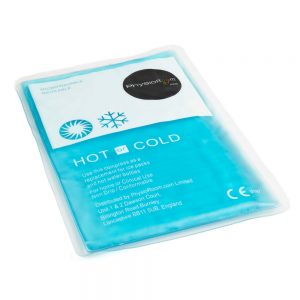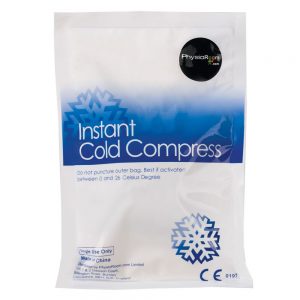It’s the 85th minute, your team is 1-0 down when the ball is headed from your area and falls in to your path. There’s green grass ahead of you, the counter is there, this is it, your chance at glory, equalise and become a hero.
But just as you get in to your stride, that left-back who’s been giving you abuse all game clips at your heels and takes you down in an Ole Gunnar Solskjaer like fashion. On the way down you take a nasty knock to your knee, and as the game finishes and your team loses, you’ve also now got an injury to deal it.
So what are the first steps?
Well, one of the most important things to do before deciding on any treatment for any injury is to assess it, find out just what exactly is wrong.
There are a number of injuries that can be helped by a cold/hot compress or pack, but it’s important to know which is which. Generally, if you’re using a hot or cold pack, you’ll be looking at a minor bumps and bruises that don’t require further medical assistance.
Some however, like breaks, dislocations and concussions require emergency medical treatment. So if you’re ever unsure, visit a doctor or hospital to receive the proper diagnosis and treatment.
For further information on how to decide between hot and cold though, you can visit our blog on the subject.
First, we must evaluate any potential injury.
If Fractured: The first thing to do is check for a fracture. You can apply a cold compress to a broken bone to reduce pain and swelling and provide temporary pain relief, however this should only be used while waiting for help from medical professionals and should not be a substitute for treatment.
We’d all love to live in a world where £0.69p hot and cold packs could fix broken bones, but sadly it doesn’t exist! Go to hospital if you find any of the following symptoms:
- Misshapen or deformed body part. Meaning, if there’s a big bend in your arm where there shouldn’t be, there’s a good chance you’ve broken it.
- Severe pain when the body part is moved or pressure applied to it.
- Blacking out or fainting with pain
- Unable to stand up or weight bare through the injured limb
- Loss of function in the area of the break, which means if you break your arm, you may have trouble moving your hand.
- Finally, if you quite literally have a bone poking through your arm, well, that one’s a dead giveaway.
If Dislocated: After ruling out any fractures, we have to check for dislocations. A dislocation is when one or both of the bones that make up a joint are jolted from their normal position…or location, hence the name. A dislocation will also require medical attention but you can again use a cold compress while waiting for assistance.
Now remember, any of these, get yourself to hospital:
- Deformed or out of place joint
- Swelling and/or bruising around the joint.
- Severe pain, which may be the most noticeable, unfortunately.
- Immobility of the area below the dislocated joint.
If Concussed: Finally, before activating that ice pack, make sure you’re not concussed. Of course, you’ll often use an cold compress on the head for bumps and bruises but as concussion is a serious injury that requires medical attention, it’s important to rule it out. Furthermore in the days following a bump on the head or heavy fall, keep vigilant to symptoms of concussion as even in the days and weeks following a head injury, concussion can manifest.
The nature of concussion means it’s often hard for the sufferer to check themselves, so have someone else check with you for the following:
- Loss of consciousness; even if you lose consciousness for just a moment, it could very well be a sign you’re concussed, seek help.
- Severe headache.
- Confusion, dizziness and disorientation.
- Ringing in the ears
- Slurred or laboured speech
- Nausea/Vomiting
Now we’ve figured out what it’s not, let’s take a look at what it is and what you’ll need:
Cold Therapy: Has this injury just happened? Is it swelling up? Is it painful and inflamed? Cold therapy is your best bet here.
Heat Therapy: Heat is good for sore muscles not necessarily associated with any specific or an acute injury. It can be used on aching muscles after and also before a sporting activity that usually causes aching muscles in order to loosen and warm them up.
For further information on how to decide between hot and cold, you can visit our blog on the subject.
The time has now come for some application. As we do though, we need to figure out what we’re going to use as a compress, we’ll concentrate on cold:
If using as a cold compress, follow these steps:
- Elevate the body part: This will allow blood to drain away from the area and fight swelling. A best case scenario is the body part being lifted above the heart, in order to utilise gravity and improve drainage back to the body’s core. So let’s say your wrist is injured, you would sit in a chair with your arm lifted up/balancing on something head height.
- Wrap the compress in a towel: This will depend on the specific pouch or pack, some may ask you to wrap the pouch in a towel to avoid direct contact with the skin which helps avoid any nasty frostbite and ice burns. Always read the manufacturers instructions!
- Apply the compress: Now apply the pack to the effected area ensuring that the entire surface receives adequate exposure. It’s also possible to create a wrap using a bandage that will enable you to not have to hold the pack yourself. However be careful not to wrap this too tight! Keep checking the area as the numbness from the cold may mask how tight you have applied the compress.
- Remove the compress: After 15 to 20 minutes you should remove the pack to avoid risk of frostbite and skin damage from ice burns. It’s important to avoid falling asleep while applying a cold compress, so set an alarm if you’re tired. If you used an instant cold pack, throw it away, if you used a reusable pouch, throw it back in the freezer ready for round two.
- Repeat Process after two hours: After you’ve iced your injury for 15-20 minutes, wait two hours and start the process again. Alternate 20 minutes on, two hours off for three days or until the swelling subsides.
Now, you could always throw a towel in the freezer and hope for the best, but here at PhysioRoom.com we like to be at the very tip of the hot and cold therapy spear, so no bags of peas here.
Here are a couple of options to cool or heat until your hearts content:
Gel-Based Packs:

Gel-based hot or cold packs, or pouches, or compresses, whatever term you prefer, are a pouch that contains soft gel that conducts heat or cold.
The PhysioRoom.com Reusable Hot / Cold Gel Pack is the best of both worlds. This versatile 25cm x 17cm mouldable pack can be used as either a hot OR cold pack, meaning you can use it as an ice pack in the early stages of injury and use it as a heat pack down the line to speed up the healing process.
To use a gel pack, simply cool in the refrigerator or freezer is intending to use as a cold pack, or warm in hot water (or microwave) to use it as a heat pack.
Instant Packs:

Instant packs, be it hot or cold, are pouches that contain a burstable liquid pouch that when burst reacts with the chemicals inside to conducts cold or heat. These products are ideal for pitch side first aid bags or taking to competitions.
The PhysioRoom.com Instant Ice Pack is a 22cm x 14cm pouch is a good example, it can be used any time, anywhere and is perfect for pitchside or when you don’t have access to a freezer or ice.
No pre-planning needed here, just activate the ice pack by squeezing the internal compartment. This starts a chemical reaction that instantly makes the pack cold. The Instant Ice Pack stays cold for 15 to 20 minutes, making it ideal for the early treatment of sports injuries.


